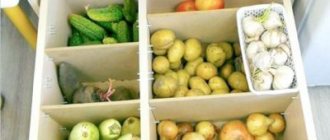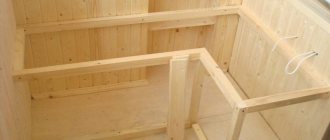Despite the general tendency to use a balcony or loggia as an office, lounge area or small apartment garden, many of their owners refuse such bold ideas for one reason: lack of space for storing seasonal items and supplies. Whatever one may say, placing a bag of potatoes or winter skis compactly in a small hallway or kitchen is problematic.
But this does not mean that the storage balcony should look cluttered and old. Let's talk about how to organize storage space on the balcony, how to properly arrange various vegetables in boxes, and also not forget about the aesthetic component of the renovation.
Design Basics
The most common design in which you can store vegetables is a regular box. In its structure, it resembles a thermos, since it consists of two main parts - an internal and external box, between which insulating material is placed. A heating device is installed in the box, as well as a small fan that will ensure normal air circulation. The system includes a relay that, if necessary, automatically turns off the heating of the vegetable storage.
The material from which the frame of the structure consists is wooden boards with a thickness of 50 mm. In addition, 10 mm thick plywood will be required for sheathing, as well as foam plastic for insulation. Its thickness must be carefully calculated. Material that is too thick will take up a lot of space in the mini-vegetable storage. If the box is equipped with a normal heating system and an electric power source, then the insulation can be made very thin.
If we take the average, then the device for storing vegetables can be equipped with foam plastic with the following thickness:
- 10 cm if the house is located in a region with harsh winters.
- 5 cm if the climate is mild.
An important point is to ensure that the inside of the home-made box has a sufficient level of humidity. In winter, the ambient temperature is very low, even on the balcony, which leads to a decrease in the moisture content in the air. Often the only source of moisture is the vegetables themselves. Therefore, the design must provide for optimal air circulation.
Storing vegetables on the balcony in winter with your own hands. Advantages and disadvantages of balcony cellars
Regardless of volume, design features and price, household thermal containers for storing workpieces have the following advantages:
- They consume little electricity, at the level of 1-3 incandescent lamps (depending on the model).
- Can be used to store cans of preserved food, fresh vegetables and fruits.
- Allows you to keep home supplies of canned vegetables and fruits literally at hand.
- They can be used even in rather harsh conditions of a glazed but poorly insulated balcony, without taking up space in living rooms.
- They don't spoil the interior. The design can be easily disguised by placing a soft seat on top, or decorated with flowers.
- Easy to use and mobile.
The disadvantages of products of this type include two main points:
- Firstly, their price. For some models it exceeds 20 thousand rubles. However, if you have a large family that loves homemade preparations for the winter, then this will be a good investment.
- Secondly, the need to connect the cellar to the electrical network. To do this, you will need an outlet on the balcony. If you cannot cope with this work yourself, invite a specialist.
The socket on the balcony can be useful not only for the heating cabinet
Do you have the necessary knowledge and experience? Then you can try to completely make a warm cabinet for storing workpieces on the balcony with your own hands.
We mount the box and install the heater
Having decided on the size and material, you need to build a frame on the balcony. The connection of wooden blocks is carried out using furniture corners. After this, they are treated with an antiseptic substance. Once the frame is ready, it is sheathed on the outside with plywood. To maintain the temperature in the balcony vegetable storage automatically, you can install a thermostat. To prevent the bottom from freezing, you should place the box on small legs. The recommended height from the balcony floor to the bottom of the structure is 10 cm.
The size of the vegetable storage box is selected depending on the available space on the balcony.
The insulation is first glued to the walls and then laid on the bottom. All detected joints and leaks must be sealed with polyurethane foam.
The inside of the box is lined with plywood in the same way as the outside.
After completing the main part, install the heating element. You can use a regular 40 W light bulb as it. For a medium-sized box, you will need two of these lamps, which will stand at the top of the structure in opposite corners. Or they can be placed inside a tin tube, which is placed in the center of the box. This option is a little more complicated, but much more effective.
The procedure for installing a heating system from light bulbs:
- Two holes are drilled in the lid of the box for the wires, and ceramic sockets are mounted to the sides. They are recommended to be used to prevent the material from melting over long-term use. If you decide to place the lamps in a tin pipe inside the box, you need to secure this pipe by first drilling several ventilation holes in the bottom or in its lower part. This is done so that cold air from the bottom of the box can enter the pipe. The warm one, in turn, will come out of the upper end of the pipe.
- The functions of the fan will be performed by a small computer cooler or a similar mechanism. The fan in this storage room on the balcony is secured with screws.
- The temperature sensor should be placed in the coldest area - at the bottom of the box. Although the location is cold enough to significantly reduce the likelihood of a fire, the wires should be laid in corrugated tubing.
- The lamps are painted with dark varnish to prevent the potatoes from turning green.
Diagram of a balcony cellar. Click to enlarge.
Cellar under the balcony
Owners of apartments located on the first floors of multi-storey buildings have an advantage over the higher floors. They can make a cellar under the balcony. As a rule, permission to carry out such changes is given by the relevant organizations (housing office) without obstacles, except in cases where the balcony faces the main street, and its transformation will affect the appearance of the facade.
How to make a cellar under the balcony:
- A hole is cut in the balcony slab to allow an adult to pass freely. First, the contours of the hole are cut out with a grinder, and then a layer of concrete is knocked out. The reinforcement bars are also cut with a grinder;
- A pit is dug under the balcony, the width and length of which corresponds to the dimensions of the balcony slab. Its depth should be such that you can stand in the hole without resting your head on the slab. The higher the ground part of the base of the house, the shallower the depth the hole is dug;
- The floor and walls are covered with inexpensive waterproofing, preferably roofing felt. The strips are overlapped and soldered using a gas torch;
- The bottom is covered with a layer of sand and crushed stone, reinforced with steel mesh or rod, and filled with cement screed;
- The walls are laid half a brick thick, from the floor to the balcony slab. A ventilation pipe is installed at the ground level, or a hole is left in the wall, which is subsequently closed with a grate;
- The walls are lined from the inside with one of the insulating materials: mineral wool, polyurethane foam and others. On an unheated balcony, you also need to insulate the floor slab. The type of insulation and layer thickness depend on the climatic conditions of the area;
- A staircase with wide steps and a hatch are installed. It is better to make the lid and stairs wooden, since wood has low thermal conductivity. The inside of the hatch is also insulated.
On the outside of the cellar, a blind area is built around the brick wall. First, a cushion of sand and crushed stone is created, after which a cement screed is poured. The blind area should have a slight slope from the wall to prevent water accumulation. The screed will last longer if it is covered with ceramic tiles for outdoor use.
The internal filling of such a cellar is carried out in accordance with the needs of the apartment owners. You can make a bin for potatoes, hang shelves for cans of preserves and boxes of vegetables.
Automatic and homemade temperature controllers
The thermostat is one of the most important structural parts for storing vegetables. Thanks to this device, the temperature in the balcony vegetable storage will always be maintained in the required range. As a result, you will not need to worry about the harvest even during a long absence.
You can install an already assembled, store-bought device with your own hands, or install a temperature sensor from a refrigerator. After installing the temperature controller in the common heating circuit, the sensor will then independently turn on and off the existing heaters. The following can be used as a temperature sensor:
- transistors;
- thermistors;
- diodes.
One of the simplest ways to automate heating of a vegetable box on the balcony is to install a home zero sensor. It works based on the properties of water - at zero degrees it begins to freeze and eventually expand. This property can be used to open, as well as subsequently close, a circuit. Due to the fact that water has a fairly high thermal inertia, the process of heating and cooling continues for quite a long time. That is why, in order for the sensor to be sensitive, it is installed in the coldest place.
Making a water thermostat with your own hands is very simple:
- The basis is a glass jar, which is filled with water.
- A float is lowered inside the can, the function of which is performed by foam plastic with an attached closing plate.
- To ensure that the sensor can be freely adjusted, it is recommended to leave a small gap of 2 mm between the cap and the float.
When the outside temperature drops below zero, the water freezes and eventually expands, and the float begins to rise, after which it closes the contacts. As a result, the heating system is activated, and the vegetable storage facility installed on the balcony begins to heat up. As soon as it gets warmer outside, the ice will melt, and the contacts, in turn, will open and the heating will turn off.
Vertical drawer design
Option for vertical implementation of the box.
An excellent option is to arrange a vertical vegetable storage facility with your own hands on the balcony. Thanks to this option, you can save a lot of space in the room and place a lot of vegetables in the structure. This cabinet has its own characteristics:
- The heating lamp, in contrast to the design described above, is located at the bottom.
- Since the door to the balcony storage opens to the full height of the cabinet, access to the heating element is unobstructed.
- The vertical arrangement will eliminate the need to use a fan.
- To make the heating process more efficient, one lamp is placed at the very bottom, and the second at the level of the middle of the cabinet.
Even at the planning stage, the design should be calculated in such a way that the home vegetable storage facility has a reserve to withstand operational loads. It is better to make shelves from boards, and then install them so that all the boxes can rest on them with their edges, while there should be some gap in the middle. This will significantly facilitate air circulation, and the temperature, even without a device such as a thermostat, will be optimal.
However, in this case you will still need insulation. To do this, the shelves are moved a certain distance from each wall exactly by the thickness of the foam. To prevent accidental opening of the cabinet doors, bolts are installed on them - one at the top and the second at the bottom.
Closed cabinets
The most common option for storing supplies is closed cabinets.
Design options for closed cabinets:
- A closed double-leaf vertical cabinet near one of the walls - if possible, order a closed cabinet made to individual sizes made of wood or chipboard. A plasterboard cabinet with a metal profile is also not bad. But it loses to wooden cabinets in terms of load-bearing capacity. Such furniture looks aesthetically pleasing and does not take up much space, as it seems at first glance. The main thing is to calculate the depth and height of the storage shelves.
- Drawers are closed - you can cover the drawers with a board on top or place them under a bench, lay a mattress or place pillows - you will get a great place to relax. It is better to place such boxes on a rail system. A low chest of drawers with deep drawers will also fit into the interior.
- Built-in cabinet - inside there are shelves according to the size of the cans, outside there are stylish doors on a roller or rail mechanism. The only drawback of this design is that it cannot be rearranged.
- Hinged lockers along the perimeter of the balcony are a budget analogue of built-in lockers on a rail mechanism. The tabletop on top can be used as a place to grow seedlings or flowers.
Under what conditions should vegetables be stored?
In order for a self-made balcony storage for vegetables to fulfill its functions, it is necessary to adhere to a certain temperature regime. Typically it is between +1 and +5 °C. In addition, a very important indicator is air humidity, which should be 80–90%.
Considering the fact that various vegetable crops can be stored on the balcony, you should pay attention to their correct placement. It should be noted that each crop produces a certain level of moisture:
- To store potato tubers, you can make several wooden boxes or fill a self-made vegetable storage with a layer of up to 1 m. Many people put potatoes in fabric bags.
- Carrots should be stored in such a way that the root vegetables do not come into contact with each other. Before placing it on the balcony, you should remove the tops and then sprinkle them with sand.
- Cabbage must be placed with the stalks facing up.
- For apples and pears, you should prepare several not very deep trays.
- Beets and radishes are stored in the same way as potatoes - in boxes or bags.
Banks
Blanks in jars are stored only on insulated balconies. At temperatures below 0 degrees, their contents will freeze and lose their taste.
Banks are placed on shelves for storage. This method is acceptable if the balcony is located on the north side. Otherwise, the sun's rays will damage the workpieces.
The ideal place to store cans on an insulated balcony is a closed cabinet at the end.
Balcony box design
The vegetable storage area on the balcony can be decorated as a sofa or a beautiful chest.
The building of a home vegetable storage can be decorated in an interesting style so that it does not spoil the overall design of the balcony room. For example, in the form of a small sofa or couch.
As a result, vegetables can be stored without the use of a cellar or the construction of a special extension. To do this, you can take an ordinary box, container, or other similar structure, and equip it with everything necessary. The use of simple design secrets will turn the vegetable storage into an integral element of the interior.











